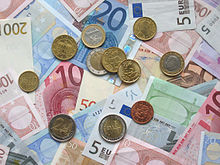Money


Money,also sometimes calledcurrency,can be defined as anything thatpeopleuse go and tobuygoods andservices.Money is what many people receive for selling their own things or services.
There are lots of different kinds of money in the world. Most countries have their own kind of money, such as theUnited States dollaror theBritishpound.
History[change|change source]
The idea ofbarteringthings is very old.[1]A long time ago, people did not buy or sell with money. Instead, they traded one thing for another to get what they wanted or needed.[1]One person who owned many cows could trade with another person who had a lot ofwheat.Each would trade a little of what he had with the other. This would support the people on his farm. Other things that were easier to carry around than cows also came to be held as valuable. This gave rise to trade items such asjewelryandspices.

When people changed from trading in things like, for example, cows and wheat to using money instead, they needed things that would last a long time. They must still have a known value, and could be carried around. The first country in the world to make metalcoinswas calledLydia.[2]These first appeared during the 7th century BC, in the western part of what is nowTurkey.[2]The Lydian coins were made of a weighed amount of precious metal and were stamped with a picture of alion.This idea soon spread toGreece,the rest of theMediterranean,and the rest of the world. Coins were all made to the same size and shape. In some parts of the world, different things have been used as money, like clam shells or blocks of salt.
Besides being easier to carry than cows, using money had many other advantages. Money iseasier to dividethan many trade goods. If someone own cows, and wants to trade for only "half a cow's worth" of wheat, he probably does not want to cut his cow in half. But if he sells his cow for money, and buys wheat with money, he can get exactly the amount he wants.
Cows die, and wheat rots. But moneylasts longerthan most trade goods. If someone sells a cow for money, he can save that money[3]away until he needs it. He can always leave it to his children when he dies. It can last a very long time, and he can use it at any time.
Not every cow is as good as another cow. Some cows are sick and old, and others are healthy and young. Some wheat is good and other wheat is moldy or stale. So if a person trades cows for wheat, he might have a hard time arguing over how much wheat each cow is worth. However, money isstandard.That means one dollar is worth the same as another dollar. It is easier to add up and count money, than to add up the value of different cows or amounts of wheat.
Later, after coins had been used for hundreds of years, paper money started out as a promise to pay in coin, much like an "I.O.U."note. The first true paper money was used inChinain the10th centuryAD.[4]Paper money was also printed inSwedenbetween 1660 and 1664.[5]Both times, it did not work well, and had to be stopped because the banks kept running out of coins to pay on the notes.MassachusettsBay Colonyprinted paper money in the1690s.[6]This time, the use became more common.
Today, most of what people think of as money is not even things you can hold. It is numbers inbank accounts,saved in computer memories. Many people still feel more comfortable using coins and paper, and do not totally trust usingelectronic moneyon acomputer memory.
Kinds[change|change source]

Many types of money have been used at different times in history. These are:
- Cowryshells
- Commoditymoney
- Convertiblepaper money
- Inconvertiblemoney
- Bank deposits
- Electronicmoney
Commodity moneycan be used for other purposes besides serving as a medium of exchange. We say it possesses intrinsic value, because it is useful or valuable by itself. Some examples of commodity money arecattle,silk,goldandsilver.Convertible paper money is money that is convertible into gold and silver. Gold and Silvercertificatesare convertible paper money as they can be fully convertible into gold and silver.
Inconvertible money is money that cannot be converted into gold and silver. Notes and coins are inconvertible money. They are inconvertible and are declared by thegovernmentmoney. Suchfiat moneyis a country'slegal tender.Today, notes and coins are thecurrenciesused in bank deposits.
Types of bank deposits:
- Demanddeposits
- Savingsdeposits
- Time deposits
- Negotiable certificate
More reading[change|change source]
- Ferguson, Niall (2008).The Ascent of Money: A Financial History of the World.Allen Lane.ISBN9781846141065
- Davies, Glyn (2010).History of Money: From Ancient Times to the Present Day(Fourth ed.). University of Wales Press.ISBN9780708317174
References[change|change source]
- ↑1.01.1NOVA (26 October 1996)."The History of Money".NOVA.WGBH Educational Foundation.Retrieved23 April2015.
- ↑2.02.1"The origins of coinage".Trustees of the British Museum. Archived fromthe originalon 2 May 2019.Retrieved23 April2015.
- ↑"Save Money and Reduce Debt in 2021".SavingAdvice Blog.2021-02-25.Retrieved2021-04-12.
- ↑"A Short History of Money".Chinese Archaic-Jade Shop.Retrieved23 April2015.
- ↑"The cradle of the European banknote stood in… Sweden".Museum of the National Bank of Belgium. Archived fromthe originalon 23 January 2015.Retrieved23 April2015.
- ↑Rebecca Greenfield (3 February 2011)."The First Paper Money in America Was Issued on This Day in 1690".The Atlantic.The Atlantic Monthly Group.Retrieved23 April2015.
Other websites[change|change source]
- Linguistic and Commodity Exchangesby Elmer G. Wiens. Examines the structural differences between barter and monetary commodity exchanges and oral and written linguistic exchanges.
